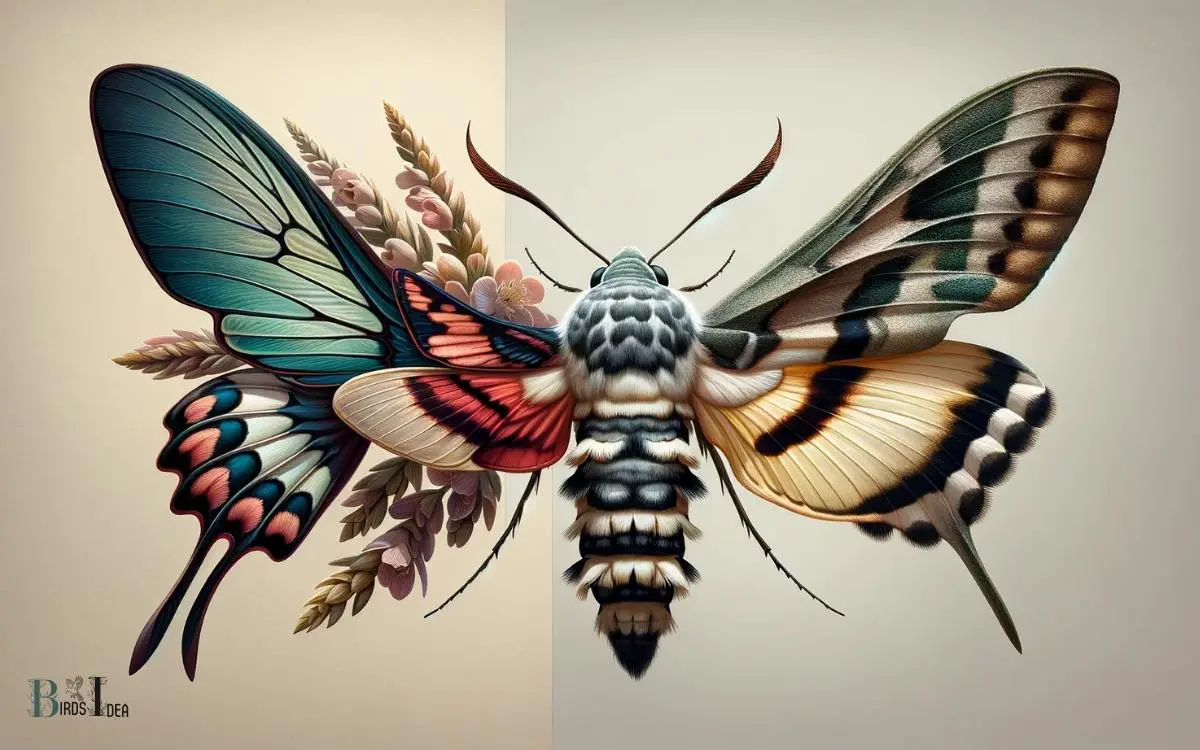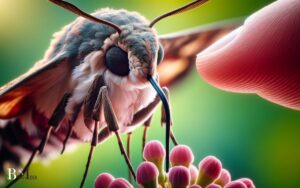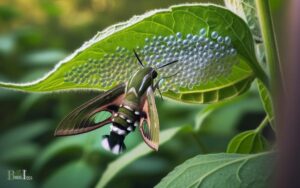Snowberry Clearwing Hummingbird Moth Caterpillar: Discover!
The Snowberry Clearwing Moth (Hemaris diffinis) and the Hummingbird Moth (Hemaris thysbe), often mistaken for hummingbirds, belong to the Sphingidae family.
Their resemblance to hummingbirds is due to their similar size, rapid wing movement, and ability to hover while feeding on nectar.
However, they can be distinguished by their physical traits, preferred habitats, and specific plant associations for feeding and laying eggs.
The Snowberry Clearwing Moth and the Hummingbird Moth exhibit unique identifying features:
Both species have a proboscis for drinking nectar and are active during the day, especially at dusk.
Distinguishing between these mimic moths is key to appreciating the diversity and complexity of their behaviors and habitats.

Key Takeaway
7 Common Features Snowberry Clearwing vs. Hummingbird Moth
| Feature | Snowberry Clearwing Moth (Hemaris diffinis) | Hummingbird Moth (Hemaris thysbe) |
|---|---|---|
| Size | Smaller, 1.25-2 inches wingspan | Larger, 1.5-2 inches wingspan |
| Body Coloration | Black and yellow bands, bumblebee-like | Olive-green and burgundy |
| Wing Appearance | Clear with a reddish-brown border | More pronounced clear wings |
| Habitat | Gardens, edges of forests, and meadows | Wide range, including gardens |
| Feeding Preferences | Prefers snowberry, honeysuckle, and viburnum | Favors honeysuckle, hawthorn, and wild roses |
| Egg-Laying Plant Associations | Snowberry and dogbane | Varies, but includes honeysuckle |
| Activity Period | Daytime, especially at dusk | Daytime, especially at dusk |
Physical Characteristics
The Snowberry Clearwing Moth and the Hummingbird Moth both exhibit distinct physical characteristics.
These moths are often mistaken for hummingbirds due to their similar appearance and behavior.
Both species have long, narrow bodies and wings that beat rapidly, allowing them to hover in front of flowers while feeding.
The most striking physical feature of these moths is their transparent wings, which are devoid of the scales that are typical of most moths.
This gives them a delicate, ethereal appearance while in flight. Additionally, their bodies are covered in fuzzy hairs, and they have a long, slender proboscis for feeding on nectar.
These physical traits make them well-adapted for their role as important pollinators in their ecosystems. Moving on to their habitat and range, both species can be found in a variety of environments.
Habitat and Range
Both moths, being adaptable to various environments, can be found in North and South America, inhabiting open woodlands, gardens, and meadows.
The Snowberry Clearwing Moth and Hummingbird Moth have overlapping habitats, allowing them to coexist in similar ecosystems.
| Habitat | Snowberry Clearwing Moth | Hummingbird Moth |
|---|---|---|
| North America | Throughout the continent, including Canada, the United States, and Mexico. | Predominantly in the southern regions, such as Florida and Texas. |
| South America | Found in countries like Brazil, Argentina, and Venezuela. | Widely distributed across various countries, including Brazil, Peru, and Ecuador. |
| Open Woodlands | Often spotted in wooded areas with clearings and edges. | Commonly seen in forests with open spaces and clearings. |
| Gardens and Meadows | Frequently seen in gardens with flowering plants and in open meadows. | Attracted to gardens with nectar-rich flowers and in open grasslands. |
Both moths have a wide range, making it possible for enthusiasts to observe them in diverse environments throughout the Americas.
Behavior and Mating
Adapting to similar environments, Snowberry Clearwing Moth and Hummingbird Moth exhibit distinctive behaviors and mating patterns.
Both species are diurnal and are often observed hovering near flowers while feeding. During courtship, male moths perform elaborate flight displays to attract females.
Snowberry Clearwing Moths tend to mate in the late afternoon, while Hummingbird Moths are more active during the morning hours.
Mating behavior also differs, with Snowberry Clearwing Moths engaging in brief, erratic flights before copulation, whereas Hummingbird Moths engage in a slower, more deliberate mating ritual.
After mating, female moths lay their eggs on host plants, with Snowberry Clearwing Moths preferring honeysuckle and snowberry plants, while Hummingbird Moths favor plants such as hawthorn and viburnum.
Understanding these behaviors sheds light on the distinct ecological roles these moths play in their respective habitats and ecosystems.
Transitioning to feeding preferences, their mating behaviors also impact their foraging patterns.
Feeding Preferences
Both the Snowberry Clearwing Moth and the Hummingbird Moth share similar nectar preferences, often feeding on the same types of flowers.
However, their feeding behaviors differ significantly, with the Snowberry Clearwing Moth being more likely to feed at dusk or dawn, while the Hummingbird Moth is active during the day.
Understanding these distinctions in feeding preferences provides valuable insights into the ecological roles of these fascinating insects.
Similar Nectar Preferences
The Snowberry Clearwing Moth and the Hummingbird Moth both prefer to feed on the nectar of tubular flowers.
This preference for specific types of flowers influences their foraging behavior and has implications for the plants they pollinate.
Their similar nectar preferences are evident in the following ways:
- Both moths are attracted to flowers with long, tubular shapes.
- They have a preference for flowers with a sweet, fragrant scent.
- These moths are often seen hovering around flowers such as honeysuckle, bee balm, and phlox.
- Their feeding activity is characterized by a rapid, darting motion as they insert their long proboscis into the flower to extract nectar.
Understanding their shared nectar preferences provides insight into their ecological roles as pollinators and their impact on the plant communities they inhabit.
This sets the stage to explore their different feeding behaviors.
Different Feeding Behaviors
Having established their shared preference for nectar from tubular flowers, both moths exhibit distinct feeding behaviors, influencing the specific types of plants they pollinate.
The Snowberry Clearwing Moth (Hemaris diffinis) tends to feed during the early morning and late afternoon, targeting flowers such as honeysuckle, snowberry, and dogbane.
Its feeding behavior involves hovering briefly in front of a flower before inserting its proboscis to feed.
In contrast, the Hummingbird Moth (Hemaris thysbe) is diurnal and favors mid-day feeding, often visiting flowers like bee balm, phlox, and verbena.
This species hovers in front of the flower, much like a hummingbird, and extends its long proboscis to access the nectar.
These different feeding behaviors have consequences for the plants they pollinate, contributing to the diversity and distribution of flowering species in their habitats.
Life Cycle and Metamorphosis
The metamorphosis of these moths involves distinct stages, including egg, larva, pupa, and adult.
The life cycle of Snowberry Clearwing Moths and Hummingbird Moths follows a similar pattern.
Here are the stages of their metamorphosis:
- Egg: The life cycle begins with the female moth laying eggs on the underside of leaves or stems of the host plant.
- Larva: Once the eggs hatch, the larvae emerge and begin to feed on the leaves of the host plant, growing in size as they consume food.
- Pupa: The larva eventually transforms into a pupa, encased in a cocoon or chrysalis, where it undergoes a remarkable metamorphosis.
- Adult: Finally, the fully developed adult moth emerges from the pupa, ready to continue the life cycle by seeking a mate and reproducing.
This transformation from egg to adult is a fascinating process essential to the survival of these remarkable insects.
What Do Snowberry Clearwing Hummingbird Moth Caterpillars Look Like?
The hummingbird moth caterpillar discovery reveals that the snowberry clearwing moth caterpillars have green bodies with white stripes and black spots, resembling young bird droppings. They have a stout body with a black horn at the rear. This unique appearance helps them blend in with their surroundings and avoid predators.
Importance in Ecosystem
Both moths play a crucial role in pollination within their respective ecosystems. The Snowberry Clearwing Moth and the Hummingbird Moth are important pollinators, transferring pollen from one flower to another as they feed on nectar.
This process is essential for the reproduction of many plant species. As they visit flowers to feed, their bodies inadvertently collect and distribute pollen, aiding in the fertilization of plants.
The Snowberry Clearwing Moth contributes to the pollination of various wildflowers and shrubs, while the Hummingbird Moth is known for its role in pollinating garden plants such as bee balm and phlox.
Without these moths, many plant species would struggle to reproduce, leading to significant consequences for the entire ecosystem.
Their role in pollination highlights their importance in maintaining the balance and diversity of plant life.
Conclusion
The snowberry clearwing moth and the hummingbird moth are both remarkable creatures with unique features and behaviors.
Their presence in the ecosystem serves an important role in pollination and maintaining the balance of various plant species.
As an anachronism, it’s like watching a miniature helicopter gracefully fluttering through the garden, providing a fascinating glimpse into the intricate world of nature and wildlife. These moths are truly captivating and essential to the environment.






